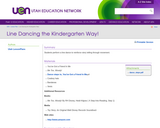
In this lesson students perform a line dance to reinforce story telling through movement.
- Subject:
- Arts and Humanities
- Performing Arts
- Material Type:
- Lesson Plan
- Provider:
- Utah Education Network
- Date Added:
- 07/09/2020

In this lesson students perform a line dance to reinforce story telling through movement.
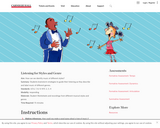
Students brainstorm strategies to guide their listening as they describe and label music of different genres.

This is a dance performance assessment created by the Michigan Arts Education Assessment and Instruction project (MAEIA).
Students will create a dance phrase based on a specific animal living in a specific habitat. The student will then consider what adaptations the chosen animal would have to make if it was moved to a distinctly different habitat and create a variation based on the proposed adaptations. This task could be modified for use with third- and fourth-grade students by eliminating the variation.
This item has not been field-tested by Michigan teachers.
This performance assessment addresses the following standard(s):
Content Standard(s)
ART.D.II.EL.4 – Create a dance phrase, accurately repeat it, and then vary it making changes in the elements of dance: time, space, force, and energy.
ART.D.II.3.4 – Demonstrate the ability to make a movement sequence using the elements of time, space, and force.
ART.D.II.4.4 – Demonstrate the ability to design a movement sequence using factors of the elements of time, space, and force.
ART.D.II.5.4 – Create a dance phrase, accurately repeat it, and then vary it by making changes in the elements of dance: time, space, force, and energy.
Performance Standard
D.EL.C.1 – Students can create stationary, axial, and locomotor movement, apply level/tempo/dynamic change, and assemble movement based on literal and abstract concepts.
NCAS Anchor Standard
DA:Cr2 – Organize and develop artistic ideas and work.
Click "view resource" to access more information about the item, including the student booklet and the scoring rubric.
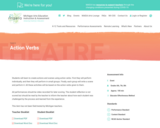
This is a theatre performance assessment created by the Michigan Arts Education Assessment and Instruction project (MAEIA).
Action Verbs:
Students will learn to create actions and scenes using action verbs. First they will perform individually, and then they will perform in small groups. Finally, each group will write a scene and perform it. All these activities will be based on the action verbs given to them.
All performances should be video recorded for later scoring. The student reflection is not scored but should be read by the teacher to inform the teacher about how each student was challenged by the process and learned from the experience.
This item has not been field-tested by Michigan teachers.
This performance assessment addresses the following standard(s):
Content Standard(s)
ART.T.I.MS.2 – In an ensemble, interact as the invented characters in improvised and scripted scenes.
ART.T.I.8.2 – Utilize role-playing and characterization skills to perform in ensemble scenes.
Performance Standard
TH.MS.P.2 – Demonstrate acting skills that reflect clear artistic choices.
NCAS Anchor Standard
TH:Pr5 – Develop and refine artistic technique and work for presentation
Click view resource to access more information about the item, including the teacher and student booklets and the scoring rubric(s).

This is an arts performance assessment created by the Michigan Arts Education Assessment and Instruction project (MAEIA).
Audience Etiquette and Impact:
Students will work collaboratively to research audience etiquette and the impact of audience on a performer and their performance.
This item has been voluntarily field-tested by Michigan teachers with a non-representative sample of students.
This performance assessment addresses the following standards:
Content Standard(s)
ART.T.III.HS.6 – Articulate and justify personal aesthetic criteria for critiquing dramatic texts and events that compare perceived artistic intent with the final aesthetic achievement.
Performance Standard
TH.HS.R.1 – Articulate how audiences impact a performance, and how individual audience members bring their own perspective and aesthetic criteria to bear upon their viewing experiences.
VPAA Guideline
R.4 – Experience, analyze, and reflect on the variety of meanings that can be derived from the results of the artistic/creative process.
NCAS Anchor Standard
TH:Re9 – Apply criteria to evaluate artistic work.
Click view resource to access more information about the item, including the teacher and student booklets, the scoring rubric(s), and student exemplars.

This is a dance performance assessment created by the Michigan Arts Education Assessment and Instruction project (MAEIA).
Choreography/Dance for Camera: Student will create, as a solo, a movement phrase that uses a specific choreographic device/structure.
This item has not been field-tested by Michigan teachers.
This performance assessment addresses the following standard(s):
Content Standard(s)
ART.D.II.HS.6 – Create a dance and revise it over time using multi-media equipment, such as slides, camera, video, and computers to articulate the reasons for artistic decisions and what was lost and gained by those decisions.
Performance Standard
C.1 – Students create solo and ensemble movement phrases and choreography, contribute choreography consistent in style and intent of performance theme, and craft thoughtful movement phrases and dances with a point of investigation and links to core content, technical acuity, and attention to space, time, and energy. Advanced students can create with technical rigor, stylistic nuance, and a sense of choreographic voice.
VPAA Guideline
P.2 – Demonstrate skillful use of appropriate vocabularies, tools, instruments, and technologies of the visual, performing, or applied arts discipline.
NCAS Anchor Standard
DA:Cr2 – Organize and develop artistic ideas and work.
*Click view resource to access more information about the item, including the teacher and student booklets and the scoring rubric(s).

This is a music performance assessment created by the Michigan Arts Education Assessment and Instruction project (MAEIA).
Compose a Harmony Line: Students will compose a harmonizing part for a four- to eight-measure excerpt from a piece of music being used in their music class. The teacher will carefully chose a four- to eight-measure excerpt for each instrument or voice from one of the songs being studied in the class.
The students will be given time in class to create a harmony line of equal length for their principal instrument. At the end of the class period, the teacher will collect their completed work. The following music class, they will perform their harmony parts while another student or the teacher performs the original melody. Audio or video recording may be used for further reference in the project.
This item has been voluntarily field-tested by Michigan teachers with a non-representative sample of students.
This performance assessment addresses the following standards:
Content Standard(s)
ART.M.II.HS.4 – Compose music in several different styles, and demonstrate creativity in using elements of music for expressive effect.
Performance Standard(s)
M.HS.C.1 – Demonstrate an appropriate level of musical understanding through interpretive decisions made when composing, improvising or arranging music.
VPAA Guideline(s)
C.3 – Understand, recognize, and use the elements, organizational principles, patterns, relationships, techniques, skills, and applications of the visual, performing, or applied arts discipline.
NCAS Anchor Standard(s)
MU:Cr1 – Generate and conceptualize artistic ideas and work.
MU:Cr3 – Refine and complete artistic work.
Click view resource to access more information about the item, including the teacher and student booklets, the scoring rubric(s), and student exemplars.

This is a music performance assessment created by the Michigan Arts Education Assessment and Instruction project (MAEIA).
Create a Different Melodic Pattern:
During the song “Six Little Ducks,” students will create a melodic phrase in response to an antecedent phrase that was performed by the teacher. Students will reflect on their performance by giving a thumbs up, thumbs down, or thumbs sideways, and first-grade students will also reflect in one sentence on why they rated their performance thumbs up, thumbs down, or thumbs sideways. The performances of students will be video recorded. Their reflections will also be video recorded.
This assessment may be more successful if someone other than the teacher supervises the video recording of the performances. If this is not possible, the teacher should be careful to ensure that students who are performing stay in the video frame during the recording process.
This item has been voluntarily field-tested by Michigan teachers with a non-representative sample of students.
This performance assessment addresses the following standard(s):
Content Standard(s)
M.II.K.2 – Create, through exploration, improvisation, and composition, an answer to a melodic question.
Performance Standard
M.EL.C.1 – Create a melodic line (e.g., a consequent phrase to an antecedent phrase, melodic line within a harmonic structure, or extending a melodic idea) using their understanding of the elements of music to inform their creative decision-making.
NCAS Anchor Standard
MU:Cr1 – Generate and conceptualize artistic ideas and work.
MU:Cr3 – Refine and complete artistic work.
Click view resource to access more information about the item, including the teacher and student booklets, the scoring rubric(s), and student exemplars.

This is an arts performance assessment created by the Michigan Arts Education Assessment and Instruction project (MAEIA).
Drawing Your Favorite Weekend Activity: Students will use pencils and crayons to create an illustration of their favorite weekend activity from personal experience. They should fill the majority of the page, using a variety of color and incorporating details of the activity into the drawing.
This item has been voluntarily field-tested by Michigan teachers with a non-representative sample of students.
This performance assessment addresses the following standard(s):
Content Standard(s)
ART.VA.III.EL.5 – Understand how personal experiences can influence the development of artwork.
ART.VA.III.K.5 – Illustrate a personal experience.
Performance Standard
VA.EL.R1 – Students can analyze, describe, and connect how art is made and the purpose it serves across disciplines and life.
NCAS Anchor Standard
VA:Cn10 – Synthesize and relate knowledge and personal experiences to make art.
*Click view resource to access more information about the item, including the teacher and student booklets, the scoring rubric(s), and student exemplars.

Quiz on melody or harmony
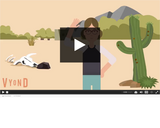
Video "The Mission"
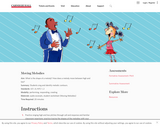
Students sing and identify melodic contours.
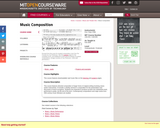
Directed composition of larger forms of original writing involving voices and/or instruments. Includes a weekly seminar in composition for the presentation and discussion of student work in progress. Students are expected to produce at least one substantive work, performed in public, by the end of the term. Contemporary compositions and major works from twentieth-century music literature are studied. Meets with graduate subject 21M.505, but assignments vary.

Music notation review

Drag and drop music notation quiz
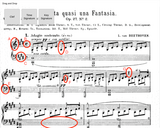
Drag and drop music notation quiz
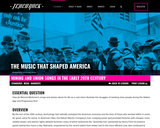
In this lesson, created in partnership with the Association for Cultural Equity, students gain a deeper understanding of what life might have been like for a working class person during this period of American history by examining the songs and stories of Nimrod Workman. Born in 1895, Workman began working in the West Virginia coal mines at fourteen years old, and continued for 42 years. By analyzing Workman's songs and personal stories, which were recorded by Alan Lomax in 1983, students gain a first-hand account of one of the most dangerous, violent, and least regulated industries in American history, and discover the relationships between labor, industry, and the government from the 1890s to the end of World War II.

In this lesson, created in partnership with the Association for Cultural Equity, students discover how the banjo and music making more generally among slaves contributed to debates on the ethics of slavery. They listen to slave narratives, examine statistics, and read primary sources to better understand how slavery was conceptualized and lived through in the 18th and 19th centuries. Throughout the lesson, students return to videos created by Alan Lomax of pre-blues banjo player Dink Roberts as a way to imagine what music among slaves in the United States may have sounded like.
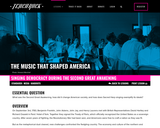
In this lesson, created in partnership with the Association for Cultural Equity, students discover the causes, characteristics, and lasting effects of the Second Great Awakening by examining the biographies of historical figures associated within the movement. They also consider how Sacred Harp Singing represents the ideals of the Second Great Awakening by watching Alan Lomax's ethnographic videos of a Sacred Harp performance.

This unit takes students through fundamental foundations of music creation that is based in both western music notation as well as technology based composition practices. The scope of the unit covers essential musical knowledge used to create music as well as a bevy of online tools used to create, collaborate and publish music.